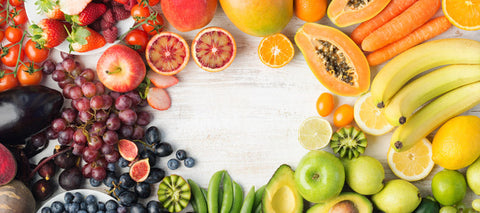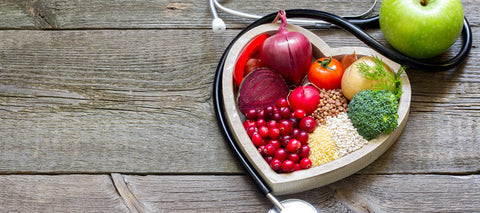Our immune health is vitally important to the rest of our overall health. The stronger our immune system, the less likely we are to fall foul of infections and illnesses that can make us sick.
The immune system is a complex system of cells, proteins and organs that recognise foreign intruders (everything from winter bugs to toxins and allergens and even a splinter in your finger) and work to kill off or neutralise the threat. Everyday life means that we’re faced with threats all the time – holding onto the handles on the train, other people sneezing, coughing and spluttering, the risk of food poisoning, airborne allergens and all manner of other bugs just waiting to take hold in our respiratory or gastrointestinal systems or on our skin.
So, what can we do? To stay as healthy as possible, it’s important to eat a wide variety of vitamin and mineral rich foods and the best way to do this is to eat the rainbow. In other words, make our plates as colourful as possible!
The Health Benefits of Vibrantly Coloured Foods
Fruits and vegetables are the obvious way of eating the rainbow, but there are other foods, some surprising, that benefit the immune system. Naturally coloured foods (we’re not talking artificially coloured sweets here) are rich in immune supporting micronutrients including the B vitamins, vitamins C, D and E, iron, selenium and zinc.
As well as these vitamins and minerals, fresh fruits and veggies are also rich in phytonutrients (a compound found in plants) and antioxidants, which also help to support a healthy immune system.
Immune Boosting Foods
Eating the rainbow might be easier than you think. Having a fully stocked fruit bowl and a fridge full of fresh vegetables will mean that you have a cacophony of coloured foods to see you through each week. Here’s some of our favourites:
Red – red peppers, red berries, red onions, tomatoes
Orange – oranges, orange peppers, carrots, sweet potatoes
Yellow – bananas, melons, lemons, yellow peppers
Green – green leafy vegetables, spinach, broccoli, kiwi fruits, peas, avocadoes
Blue, indigo and violet – blueberries, aubergines, beetroots, berries
Carotenoids are a type of antioxidant phytonutrient, usually found in red, orange and yellow foods but they can also be found in some green vegetables. There are three main types of carotenoids, found in different foods so it’s helpful to mix up the fruits and veggies you’re eating each week:
- Beta-carotene – carrots, peppers, mango, apricots, passion fruit, sweet potatoes, spinach
- Lycopene – tomatoes, watermelon, red cabbage
- Lutein – kale, collard greens, sweetcorn, spinach
There are other foods that contain antioxidant phytonutrients called flavonoids that should be included in a healthy, immune boosting diet. There are many different types of flavonoids, found in a wide variety of foods:
- Anthocyanins – blueberries, cranberries
- Quercetin – onions, apples, broccoli, black tea, red wine, dark chocolate
- Curcumin – found primarily in the spice turmeric, but also in mustard and ginger
- Catechins – green tea, black grapes, blackberries, peaches, plums
- Isoflavones – found in soya products (including tofu and miso)
- Lignans – found in flax seeds (also known as linseeds)
Eating for immunity doesn’t mean just eating salads and vegetables either. Fish such as salmon and herring, lean, white meats and eggs are all also rich in immune boosting micronutrients and protein. Mushrooms are also a good source of plant based vitamin D.
The message here is to most definitely make sure you eat a range of differently coloured foods – the more diverse, the better!












